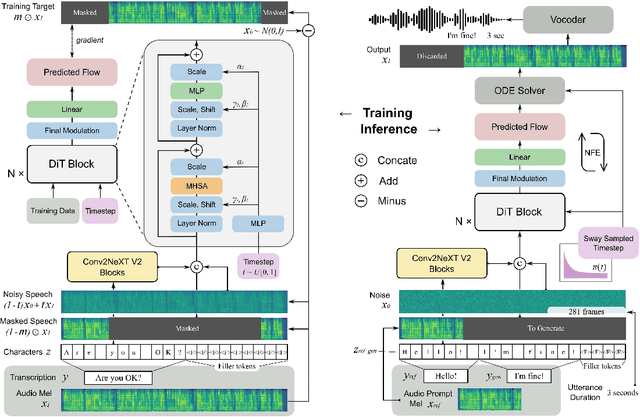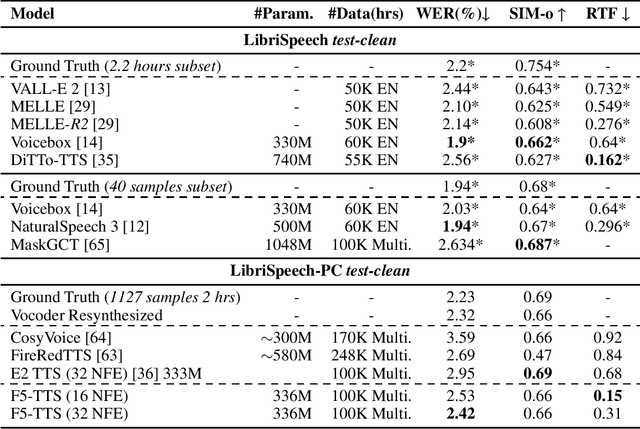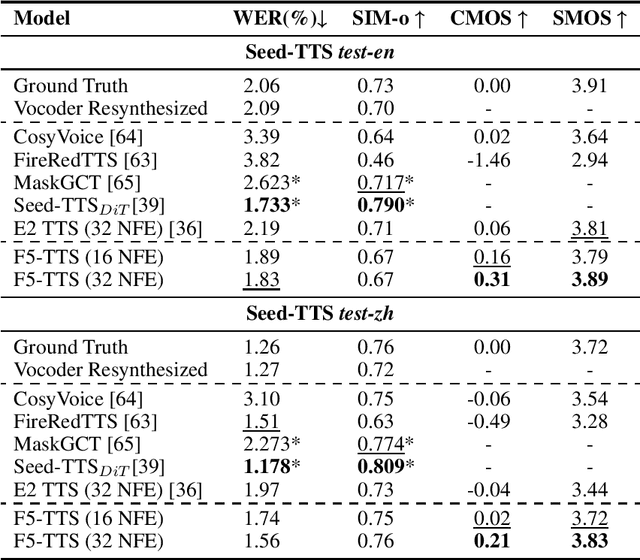Zhikang Niu
URO-Bench: A Comprehensive Benchmark for End-to-End Spoken Dialogue Models
Feb 25, 2025Abstract:In recent years, with advances in large language models (LLMs), end-to-end spoken dialogue models (SDMs) have made significant strides. Compared to text-based LLMs, the evaluation of SDMs needs to take speech-related aspects into account, such as paralinguistic information and speech quality. However, there is still a lack of comprehensive evaluations for SDMs in speech-to-speech (S2S) scenarios. To address this gap, we propose URO-Bench, an extensive benchmark for SDMs. Notably, URO-Bench is the first S2S benchmark that covers evaluations about multilingualism, multi-round dialogues, and paralinguistics. Our benchmark is divided into two difficulty levels: basic track and pro track, consisting of 16 and 20 datasets respectively, evaluating the model's abilities in Understanding, Reasoning, and Oral conversation. Evaluations on our proposed benchmark reveal that current open-source SDMs perform rather well in daily QA tasks, but lag behind their backbone LLMs in terms of instruction-following ability and also suffer from catastrophic forgetting. Their performance in advanced evaluations of paralinguistic information and audio understanding remains subpar, highlighting the need for further research in this direction. We hope that URO-Bench can effectively facilitate the development of spoken dialogue models by providing a multifaceted evaluation of existing models and helping to track progress in this area.
SLAM-Omni: Timbre-Controllable Voice Interaction System with Single-Stage Training
Dec 20, 2024Abstract:Recent advancements highlight the potential of end-to-end real-time spoken dialogue systems, showcasing their low latency and high quality. In this paper, we introduce SLAM-Omni, a timbre-controllable, end-to-end voice interaction system with single-stage training. SLAM-Omni achieves zero-shot timbre control by modeling spoken language with semantic tokens and decoupling speaker information to a vocoder. By predicting grouped speech semantic tokens at each step, our method significantly reduces the sequence length of audio tokens, accelerating both training and inference. Additionally, we propose historical text prompting to compress dialogue history, facilitating efficient multi-round interactions. Comprehensive evaluations reveal that SLAM-Omni outperforms prior models of similar scale, requiring only 15 hours of training on 4 GPUs with limited data. Notably, it is the first spoken dialogue system to achieve competitive performance with a single-stage training approach, eliminating the need for pre-training on TTS or ASR tasks. Further experiments validate its multilingual and multi-turn dialogue capabilities on larger datasets.
F5-TTS: A Fairytaler that Fakes Fluent and Faithful Speech with Flow Matching
Oct 09, 2024



Abstract:This paper introduces F5-TTS, a fully non-autoregressive text-to-speech system based on flow matching with Diffusion Transformer (DiT). Without requiring complex designs such as duration model, text encoder, and phoneme alignment, the text input is simply padded with filler tokens to the same length as input speech, and then the denoising is performed for speech generation, which was originally proved feasible by E2 TTS. However, the original design of E2 TTS makes it hard to follow due to its slow convergence and low robustness. To address these issues, we first model the input with ConvNeXt to refine the text representation, making it easy to align with the speech. We further propose an inference-time Sway Sampling strategy, which significantly improves our model's performance and efficiency. This sampling strategy for flow step can be easily applied to existing flow matching based models without retraining. Our design allows faster training and achieves an inference RTF of 0.15, which is greatly improved compared to state-of-the-art diffusion-based TTS models. Trained on a public 100K hours multilingual dataset, our Fairytaler Fakes Fluent and Faithful speech with Flow matching (F5-TTS) exhibits highly natural and expressive zero-shot ability, seamless code-switching capability, and speed control efficiency. Demo samples can be found at https://SWivid.github.io/F5-TTS. We release all code and checkpoints to promote community development.
VALL-T: Decoder-Only Generative Transducer for Robust and Decoding-Controllable Text-to-Speech
Jan 30, 2024Abstract:Recent TTS models with decoder-only Transformer architecture, such as SPEAR-TTS and VALL-E, achieve impressive naturalness and demonstrate the ability for zero-shot adaptation given a speech prompt. However, such decoder-only TTS models lack monotonic alignment constraints, sometimes leading to hallucination issues such as mispronunciation, word skipping and repeating. To address this limitation, we propose VALL-T, a generative Transducer model that introduces shifting relative position embeddings for input phoneme sequence, explicitly indicating the monotonic generation process while maintaining the architecture of decoder-only Transformer. Consequently, VALL-T retains the capability of prompt-based zero-shot adaptation and demonstrates better robustness against hallucinations with a relative reduction of 28.3% in the word error rate. Furthermore, the controllability of alignment in VALL-T during decoding facilitates the use of untranscribed speech prompts, even in unknown languages. It also enables the synthesis of lengthy speech by utilizing an aligned context window.
Fast-HuBERT: An Efficient Training Framework for Self-Supervised Speech Representation Learning
Sep 29, 2023



Abstract:Recent years have witnessed significant advancements in self-supervised learning (SSL) methods for speech-processing tasks. Various speech-based SSL models have been developed and present promising performance on a range of downstream tasks including speech recognition. However, existing speech-based SSL models face a common dilemma in terms of computational cost, which might hinder their potential application and in-depth academic research. To address this issue, we first analyze the computational cost of different modules during HuBERT pre-training and then introduce a stack of efficiency optimizations, which is named Fast-HuBERT in this paper. The proposed Fast-HuBERT can be trained in 1.1 days with 8 V100 GPUs on the Librispeech 960h benchmark, without performance degradation, resulting in a 5.2x speedup, compared to the original implementation. Moreover, we explore two well-studied techniques in the Fast-HuBERT and demonstrate consistent improvements as reported in previous work.
 Add to Chrome
Add to Chrome Add to Firefox
Add to Firefox Add to Edge
Add to Edge